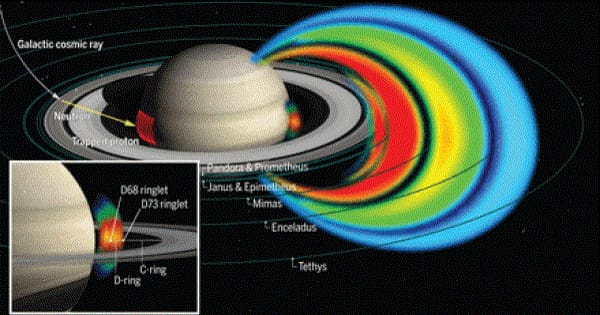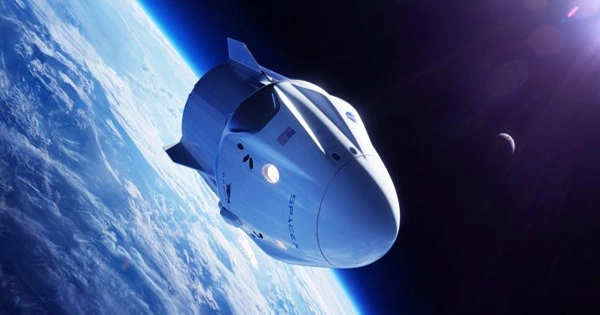High-energy oxygen and sulfur ions have been discovered in Jupiter’s inner radiation belts, as well as a previously unknown ion source. Nearly 20 years after NASA’s Galileo mission to Jupiter ended, scientists led by the Max Planck Institute for Solar System Research (MPS) in Germany have discovered a new secret in the mission’s massive data sets.
For the first time, the research team was able to establish unequivocally that the high-energy ions that surround the gas giant as part of its inner radiation belt are primarily oxygen and sulfur ions. They are thought to have formed as a result of volcanic eruptions on Jupiter’s moon Io. The team discovered an unexpectedly high concentration of high-energy oxygen ions near the orbit of Jupiter’s moon Amalthea, which orbits Jupiter further inward, which cannot be explained by Io’s volcanic activity. An ion source that was previously unknown must be at work here. The study’s findings were published in the journal Science Advances.
Planets with their own global magnetic fields, such as Earth, Jupiter, and Saturn, are surrounded by so-called radiation belts: Fast moving charged particles such as electrons, protons, and heavier ions whiz around in the magnetic field, forming the invisible, torus-shaped radiation belts. With high velocities approaching the speed of light, the particles can ionize other molecules when they collide, creating a dangerous environment that can also endanger space probes and their instruments.
Jupiter, the gas giant, has the most extreme radiation belts in the Solar System. Researchers from the MPS, the California Institute of Technology (USA), the Johns Hopkins Applied Physics Laboratory (USA), the Laboratory of Instrumentation and Experimental Particle Physics (Portugal), and the Academy of Athens (Greece) present the most comprehensive study of heavy ions in Jupiter’s inner radiation belts to date in their new publication.
The concentration and energy of oxygen ions there are much higher than expected. The energy distribution of the heavy ions outside Amalthea’s orbit suggests that they are largely introduced from a more distant region of the radiation belts.
Dr. Elias Roussos
The radiation belts of Jupiter, like Jupiter’s massive magnetic field, extend several million kilometers into space; however, the region within Europa’s orbit, with a radius of about 670,000 kilometers around the gas giant, has the highest energetic particle densities and velocities. From Jupiter, Europa is the second of four large Jovian satellites known as “Galilean moons” after Galileo, their 17th century discoverer. Io is the Galilean moon that is closest to the Sun. Three space missions have so far ventured into this innermost part of these radiation belts and performed in-situ measurements, including Pioneer 11 in the mid-1970s, Galileo from 1995 to 2003, and now Juno.
“Unfortunately, the data from Pioneer 11 and Juno do not allow us to conclude beyond doubt what kind of ions the spacecraft encountered there,” says MPS scientist Dr. Elias Roussos, lead author of the new study, describing the current state of research. “Therefore, their energies and origin were also unclear until now,” he adds. Only the now rediscovered data from the last months of the Galileo mission is detailed enough to improve this situation.
Venturing into the inner radiation belts
In 1995, NASA’s Galileo spacecraft arrived in the Jupiter system. The mission spent the next eight years providing fundamental insights into the distribution and dynamics of charged particles around the gas giant, equipped with the Heavy Ion Counter (HIC) contributed by the California Institute of Technology and the Energetic Particle Detector (EPD) developed and built by Johns Hopkins Applied Physics Laboratory in collaboration with the MPS.
To protect the spacecraft, it initially flew only through the radiation belts’ outer, less extreme regions. Galileo ventured into the innermost region within the orbits of the moons Amalthea and Thebe only in 2003, shortly before the mission’s end, when a greater risk was justifiable. Viewed from Jupiter, Amalthea and Thebe are the third and fourth moons of the giant planet. The orbits of Io and Europa lie farther outward.

“It was to be expected that the measurement data from HIC and EPD from the inner region of the radiation belt would be heavily corrupted due to the exposure to strong radiation. After all, neither of these two instruments was designed to function in such a harsh environment “Roussos describes his expectations three years ago, when he began working on the current study. Nonetheless, the researcher desired to observe for himself.
He had witnessed Cassini’s final, similarly daring orbits at Saturn two years earlier as a member of NASA’s Cassini mission and analyzed the unique data from that final mission phase. “I kept thinking about the long-completed Galileo mission,” Roussos recalls. Surprisingly, among many unusable data sets, he discovered some that could be processed and analyzed with considerable effort.
Enigmatic oxygen ions
The current study’s authors were able to determine the ion composition within the inner radiation belts, as well as the ions’ velocities and spatial distribution, for the first time with the help of this scientific treasure. In contrast to Earth’s and Saturn’s radiation belts, which are dominated by protons, the region within Io’s orbit contains significant amounts of the much heavier oxygen and sulfur ions, with oxygen ions dominating the two.
“The energy distribution of the heavy ions outside Amalthea’s orbit suggests that they are largely introduced from a more distant region of the radiation belts,” says Roussos. The moon Io, with its more than 400 active volcanoes that spew large amounts of sulfur and sulfur dioxide into space on a regular basis, and, to a lesser extent, Europa, are most likely the main sources.
Within Amalthea’s orbit, the ion composition shifts dramatically in favor of oxygen. “The concentration and energy of oxygen ions there are much higher than expected,” says Roussos. Actually, the concentration in this region should be decreasing as the moons Amalthea and Thebe absorb incoming ions; the orbits of the two small moons form a kind of natural ion barrier. This behavior has been observed in the radiation belts of the Saturnian system, which has many moons.
The only explanation for the increased concentration of oxygen ions is thus another, local source in the radiation belts’ innermost region. According to the researchers’ computer simulations, one possibility is the release of oxygen as a result of sulfur ion collisions with fine dust particles in Jupiter’s rings. The rings, which are much fainter than Saturn’s, extend roughly as far as Thebe’s orbit. However, low-frequency electromagnetic waves in the magnetospheric environment of the innermost radiation belts could also heat oxygen ions to the observed energies.
“At the moment, it is not possible to distinguish between these two possible sources,” Roussos says. Regardless, either of these two candidate mechanisms has parallels to high energy particle production in stellar or extrasolar environments, establishing that Jupiter’s radiation belts extend into the astrophysical realm, a fact that the researcher hopes will justify future exploration with a dedicated space mission.
















